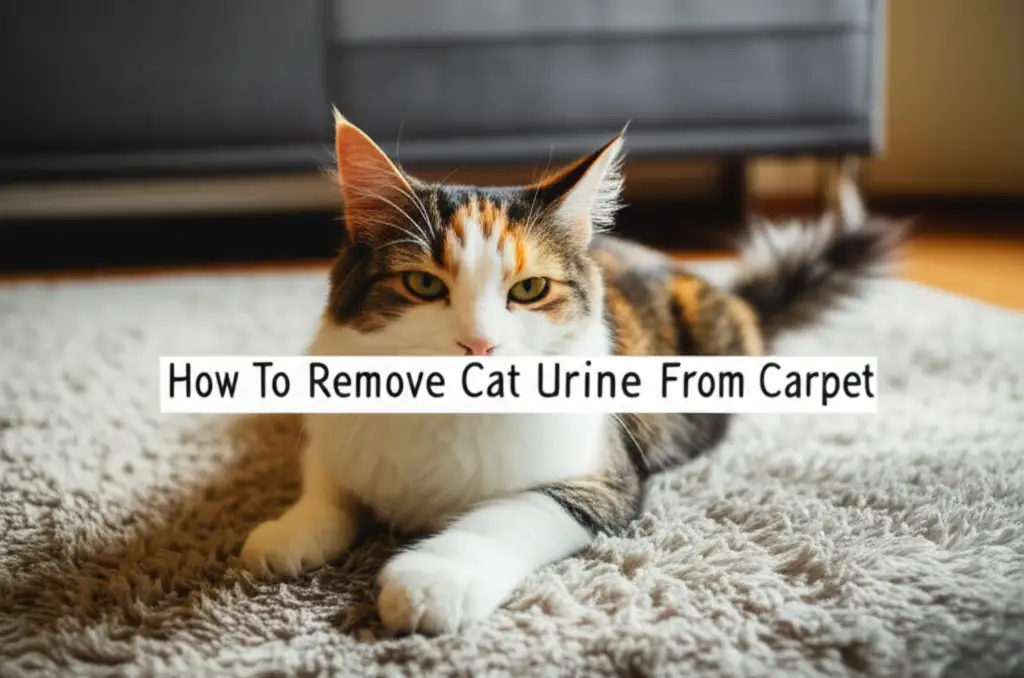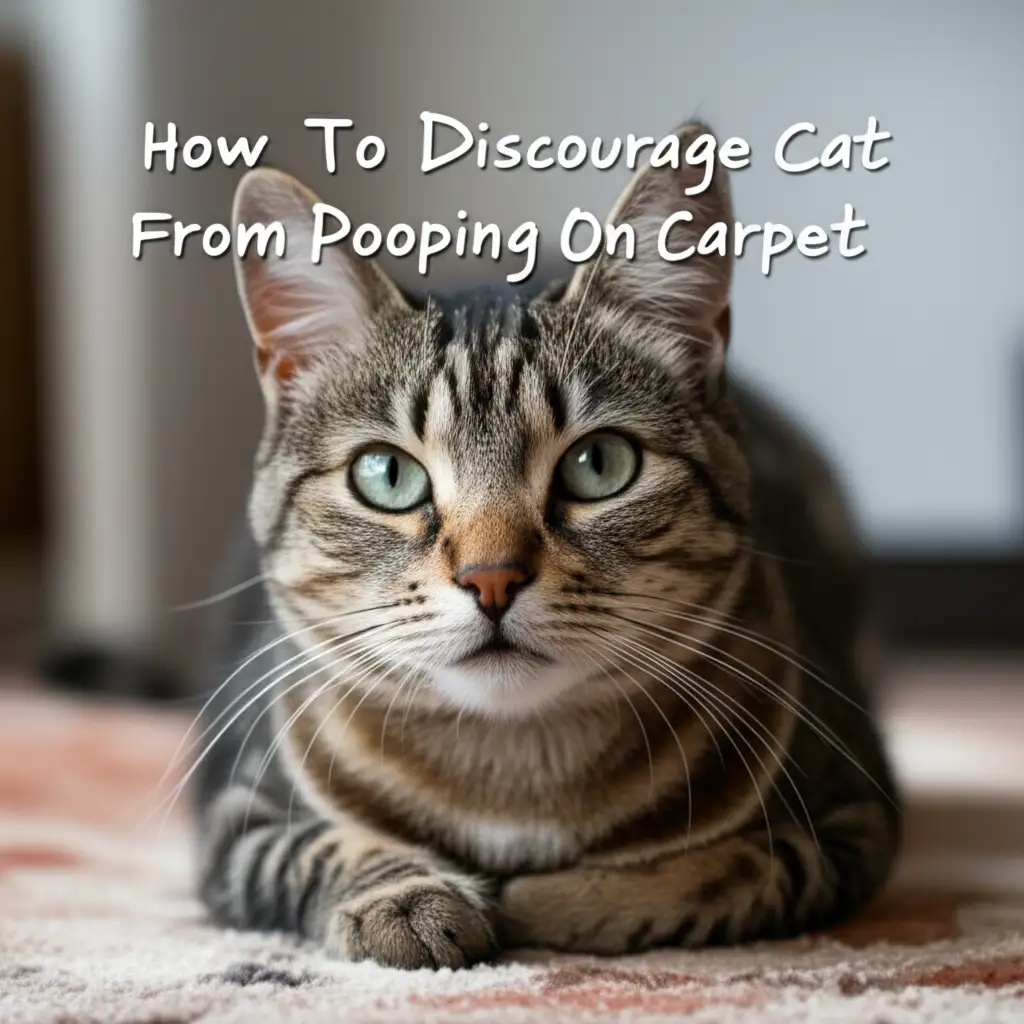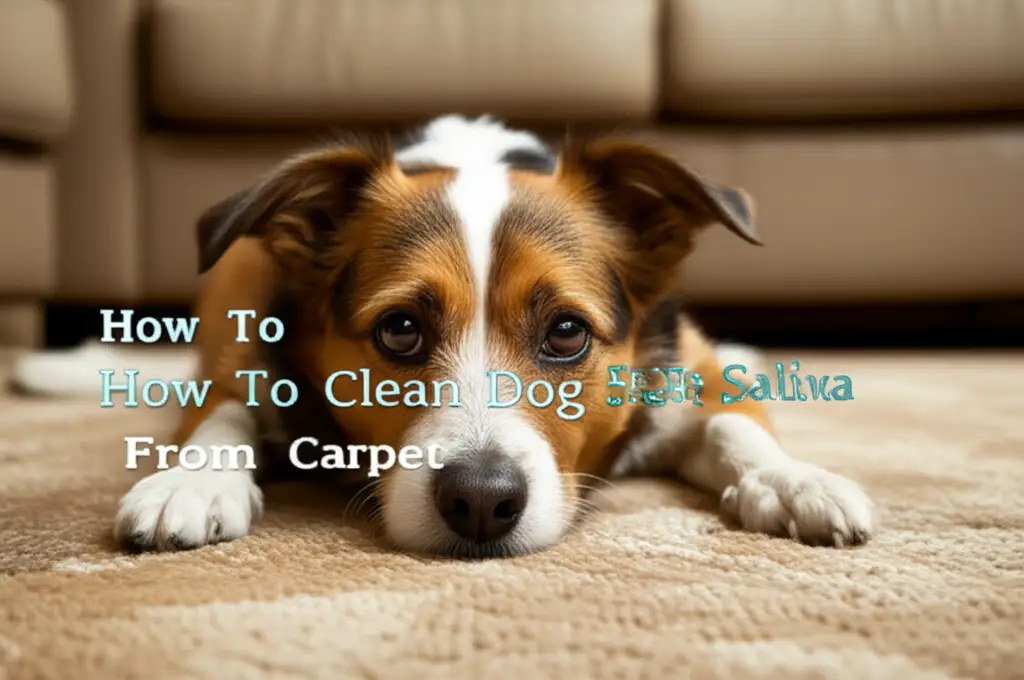· Liora Benning · Pet Care · 21 min read
How To Remove Cat Urine From Carpet

How to Remove Cat Urine from Carpet: A Complete Guide
One of the less pleasant surprises a cat owner can face is discovering a wet, odorous spot on their carpet. Cat urine not only leaves an unsightly stain but also a powerful, persistent odor. This smell comes from uric acid crystals. These crystals become more potent as they dry. Dealing with cat urine on carpet feels like a real challenge. I have faced this many times in my own home. You might feel frustrated and wonder if your carpet will ever smell clean again.
Knowing how to remove cat urine from carpet is important. It helps maintain a fresh home. It also prevents your cat from re-soiling the same spot. This guide will walk you through the steps. We will cover immediate action for fresh stains. We will explore various effective cleaning solutions. We will also look at methods for tackling dried stains and stubborn odors. My goal is to give you clear, actionable advice. You can make your carpet smell and look clean again. Let’s get your home smelling fresh.
Takeaway
Removing cat urine from carpet requires swift action and proper techniques.
- Blot fresh urine immediately. Do not rub it.
- Use an enzymatic cleaner for best results.
- Address dried stains with specialized products.
- Neutralize odors completely to deter repeat accidents.
Clear, Concise Answer
To remove cat urine from carpet, blot fresh urine quickly with paper towels. Apply an enzymatic cleaner, letting it dwell as directed to break down uric acid crystals. Blot again and allow the area to air dry completely. For old stains, use a black light to find the area before cleaning.
Understanding Cat Urine: Why It Poses a Challenge
Cat urine is distinct from other pet messes. It presents a unique cleaning problem for carpets. The reason lies in its chemical makeup. Understanding this composition helps you choose the right cleaning methods. I learned this through trial and error with my own cats. Ignoring the specific properties of cat urine often leads to frustration. The odor can linger even after cleaning.
The challenge intensifies when the urine dries. The initial liquid evaporates. This leaves behind concentrated uric acid crystals. These crystals re-activate with moisture. They release the strong, unpleasant odor. This is why a spot might smell fine after drying, then reek on a humid day. Standard cleaning products often fail to break down these crystals. They might spread the problem.
The Chemical Composition
Cat urine contains several components. These include urea, creatinine, uric acid, and various salts. Urea is the main component. Bacteria in the carpet break it down. This breakdown creates ammonia. Ammonia causes the sharp, pungent smell. This happens quickly.
Uric acid is the most problematic part. It forms crystals as the urine dries. These crystals are not water-soluble. Water alone cannot rinse them away. Common household cleaners often cannot dissolve them either. This is why the smell persists. You need specific cleaners to break down uric acid.
The Lingering Odor
The lingering odor comes from two main sources. First, the ammonia production. Second, the uric acid crystals. As these crystals dry, they bond with carpet fibers. Humidity or moisture reactivates them. This releases the odor again. This constant re-release makes the smell hard to eliminate.
Cats also have a powerful sense of smell. If any odor remains, your cat may mark the spot again. This turns into a cycle. You need to completely neutralize the odor. Simply masking the smell does not work. This is why choosing the right cleaner is crucial. Many products claim to remove odors. Only those targeting uric acid truly work.
Immediate Action: The First Steps to Tackle Fresh Stains
Acting fast is the most important step when dealing with fresh cat urine on your carpet. The sooner you address the stain, the easier it is to remove. Fresh urine has not yet had time to soak deeply into the carpet fibers or the padding below. This also means the uric acid crystals have not fully formed. I always keep cleaning supplies ready for this reason. A quick response helps prevent the odor from setting in. It also reduces the chance of a permanent stain.
My first thought when I see a fresh spot is to grab paper towels. I know that every second counts. Delay allows the urine to penetrate deeper. Once it reaches the carpet padding, removal becomes much harder. It also means a stronger, more persistent odor later on. You want to get as much liquid out as possible. This minimizes the cleanup required afterwards. Do not panic; act quickly and calmly.
Blotting the Stain
Blotting is the correct way to remove fresh cat urine. Never rub the stain. Rubbing pushes the urine deeper into the carpet fibers. It also spreads the stain over a larger area. You want to lift the urine out, not push it down.
Here is how to blot properly:
- Gather materials: Use thick layers of paper towels or a clean, old white cloth.
- Apply pressure: Place the paper towels directly over the wet spot. Press down firmly. You can stand on the towels. Your goal is to absorb as much liquid as possible.
- Replace and repeat: Change to fresh paper towels as they become saturated. Continue blotting until no more moisture transfers to the towels. The area should feel nearly dry to the touch.
- Work from outside in: If the stain is spreading, work from the outer edges towards the center. This helps prevent the stain from getting bigger. This step is critical for minimizing the affected area.
Avoiding Common Mistakes
Many people make mistakes when cleaning cat urine. These mistakes can make the problem worse. Knowing what to avoid saves you time and effort. I learned these lessons the hard way.
- Do not use a steam cleaner immediately: Heat from a steam cleaner can permanently set the cat urine odor and stain. It cooks the proteins in the urine. This makes the uric acid bond more strongly with the carpet fibers. Avoid steam cleaning until you have fully neutralized the urine.
- Do not use ammonia-based cleaners: Cat urine contains ammonia. Using more ammonia can make the spot smell worse. Cats may also confuse the smell with their own urine. This encourages them to re-mark the area.
- Do not rub the stain: As mentioned, rubbing pushes the urine deeper. It also damages carpet fibers over time. Always blot gently but firmly.
- Do not ignore the padding: Urine often soaks into the carpet padding and subfloor. If you only clean the surface, the odor will return. You need to address deeper saturation if it has occurred.
- Do not use too much water: Excessive water can spread the stain. It also makes drying difficult. Over-wetting can lead to mold and mildew growth under the carpet. Use a controlled amount of liquid for cleaning solutions.
Following these first steps sets you up for success. It prepares the area for proper cleaning solutions. A good start makes the rest of the process much smoother.
Effective Cleaning Solutions for Cat Urine on Carpet
After blotting the fresh urine, the next crucial step is to apply an effective cleaning solution. Not all cleaners are created equal when it comes to cat urine. You need products that can break down uric acid crystals and neutralize the odor at a molecular level. My personal experience shows that choosing the right product makes all the difference. Using the wrong solution can actually make the stain or odor worse.
There are several types of cleaners available. Each has its own strengths. I will explain the most effective options here. Your choice often depends on how old the stain is. It also depends on the tools you have. Always test any cleaner in an inconspicuous area first. This checks for colorfastness. You do not want to damage your carpet further.
Enzymatic Cleaners: Your Best Bet
Enzymatic cleaners are widely considered the best solution for cat urine. They contain special enzymes. These enzymes break down the uric acid crystals. They also break down other organic matter in the urine. This action eliminates the source of the odor. It does not just mask it. I always recommend these first. They work very well.
How to use enzymatic cleaners:
- Saturate the area: Pour enough enzymatic cleaner to soak the carpet fibers and padding. Ensure it reaches as deep as the urine did. This is important for thorough treatment.
- Let it dwell: Follow the product instructions for dwell time. This usually ranges from 10 minutes to several hours. Some products recommend keeping the area moist. Cover it with plastic wrap during this time. The enzymes need time to work.
- Blot excess: After the dwell time, blot the area with clean paper towels. Remove any remaining liquid.
- Allow to dry: Let the area air dry completely. This might take 24-48 hours. Keep pets away from the area during this time.
- Re-treat if needed: For severe or old stains, you might need multiple applications. Be patient. Enzymatic cleaners work, but they need time.
These cleaners also prevent future marking. The cat cannot smell its previous mark. This discourages repeat accidents.
Vinegar and Baking Soda: Natural Solutions
For those who prefer natural options, a combination of white vinegar and baking soda can be effective. This method works well for fresh stains. It also helps with lingering odors. I have used this combination many times myself. It is a good option when you do not have an enzymatic cleaner readily available. Vinegar is acidic. It helps neutralize the alkaline salts in dried urine. Baking soda absorbs odors.
Here is how to use them:
- Vinegar solution: Mix equal parts white vinegar and water.
- Apply to stain: Pour enough solution to saturate the urine spot. Let it sit for 10-15 minutes. The vinegar helps break down the uric acid.
- Blot the solution: Blot the vinegar solution thoroughly with paper towels. Get as much liquid out as possible.
- Apply baking soda: Sprinkle a generous amount of baking soda over the damp area. Ensure full coverage. The baking soda will absorb remaining odors and moisture.
- Let it dry: Leave the baking soda overnight or for several hours. Let it dry completely.
- Vacuum: Once dry, vacuum up the baking soda. The area should smell much fresher.
While effective, this method might not fully eliminate older, deeply set stains and odors. For tough cases, an enzymatic cleaner is superior. For specific issues with human urine and vinegar, you can find more information here.
Hydrogen Peroxide: For Tough Stains
Hydrogen peroxide is a strong oxidizing agent. It can help break down stubborn stains and odors. Use a 3% hydrogen peroxide solution. It is important to use this with caution. Hydrogen peroxide can bleach some carpets. Always test in an inconspicuous spot first. Do not use it on dark carpets or delicate fibers.
How to use hydrogen peroxide:
- Test first: Apply a small amount to a hidden area of the carpet. Check for color change after a few minutes.
- Apply to stain: If safe, pour a small amount of 3% hydrogen peroxide directly onto the urine stain. Do not over-saturate.
- Blot and rinse: Let it sit for 5-10 minutes. Blot the area thoroughly with clean towels. Then, lightly blot with plain water to rinse.
- Dry: Allow the area to air dry completely.
- Combine with baking soda: For extra odor absorption, sprinkle baking soda over the area after blotting the peroxide. Let it sit, then vacuum.
Hydrogen peroxide is often used for dried stains when other methods fail. It is a powerful tool when used correctly. Remember, the goal is not just to clean but to neutralize. Your carpet will smell much better.
Tackling Dried Cat Urine and Lingering Odors
Discovering a dried cat urine stain is much trickier than a fresh one. The urine has had time to bond deeply with the carpet fibers. The uric acid crystals are fully formed and set. These crystals are the main culprits for the persistent, pungent odor. I know the frustration of finding a hidden, stinky spot. It means the smell has been around for a while. You cannot always see the dried urine. This makes detection and effective removal harder.
Removing dried cat pee out of carpet requires a different approach. You must first locate all affected areas. Then, you need a powerful cleaning strategy. Standard cleaning methods will likely fail here. They might even make the smell worse. We need to break down those stubborn uric acid crystals. Only then can we truly eliminate the odor. This process needs patience and the right tools.
Locating Dried Stains
Dried cat urine stains can be invisible to the naked eye. They might leave a faint discoloration. Often, you only notice the smell. To find all soiled areas, a UV black light is indispensable. I highly recommend investing in one. It saves so much time and guesswork.
Here is how to use a black light:
- Darken the room: Turn off all lights. Make the room as dark as possible. Close curtains or blinds.
- Scan the carpet: Shine the black light slowly over the entire carpeted area. Pay close attention to corners, baseboards, and areas where your cat spends time.
- Identify stains: Cat urine will glow a yellowish-green or bluish-white under the UV light. This makes hidden stains clearly visible.
- Mark the spots: Use chalk or painter’s tape to outline the glowing areas. This ensures you treat every affected spot.
- Check padding: Remember that urine can soak through to the padding. Mark the floor area beneath as well.
Locating every spot is vital. If even a small amount of dried urine remains, the odor will persist. It will continue to cause problems. This step ensures thorough cleaning. For more details on this, see how to get dried cat pee out of carpet.
Deep Cleaning for Odor Removal
Once you have identified all dried urine spots, it is time for deep cleaning. This targets the uric acid crystals directly. This step is about removing the pet pee smell from carpet completely.
Here are the steps for deep odor removal:
- Pre-treat with enzymatic cleaner: Generously apply an enzymatic cleaner to all marked areas. Ensure the cleaner soaks as deeply as the urine did. For very old stains, you might need to reapply several times. Cover the treated area with plastic film. This keeps it moist and allows the enzymes to work longer. Let it dwell for several hours or overnight.
- Extract: After the dwell time, use a wet-dry vacuum or a carpet extractor. Extract the cleaner and dissolved urine. Do not use a steam cleaner. Steam can set the stain.
- Rinse thoroughly: Lightly rinse the area with clean water. Extract the water immediately. Repeat this rinsing and extraction until no suds appear.
- Baking soda application (optional but recommended): Once the area is as dry as possible from extraction, sprinkle a generous layer of baking soda over the spot. Baking soda helps absorb any residual odors and moisture.
- Let it dry completely: Leave the baking soda for at least 12-24 hours. The longer, the better. Ensure the area is completely dry before proceeding.
- Vacuum: Vacuum up the dried baking soda. The carpet should now be much cleaner and odor-free.
- Air out the room: Open windows and use fans to air out the room. Good ventilation helps remove any lingering airborne odors.
For persistent odors, you may need to repeat the enzymatic cleaning process. Sometimes, the padding or subfloor underneath is heavily saturated. In such cases, professional help might be needed. They can lift the carpet. They treat the padding and subfloor directly. This deep cleaning is essential. It prevents the cat from returning to the same spot. It truly removes the pet pee smell from carpet.
Protecting Your Carpet: Prevention Strategies
Cleaning up cat urine is a reactive process. A more proactive approach involves prevention. Preventing accidents saves you time, effort, and money. It also keeps your home smelling fresh. I learned that understanding why a cat urinates outside the litter box is crucial. It is rarely out of spite. It is usually a sign of an underlying issue. Addressing these issues helps prevent future incidents.
Protecting your carpet goes beyond just cleaning. It means creating an environment where your cat feels comfortable using their litter box. It also involves taking steps to make your carpet less appealing for accidents. My goal is always to keep my cats happy and my home clean. This balance prevents many problems.
Addressing the Root Cause
Cats do not pee outside the litter box for no reason. This behavior is a communication. It indicates stress, health issues, or litter box aversion. You need to investigate the reason to stop it.
Here are common reasons and solutions:
- Medical problems: A veterinary check-up is the first step. Urinary tract infections (UTIs), bladder stones, or kidney disease can cause inappropriate urination. My vet confirmed this for one of my cats. A clean bill of health rules out medical causes.
- Litter box issues:
- Cleanliness: Cats are very clean. A dirty litter box is often the main reason. Scoop daily. Change the litter completely weekly or bi-weekly.
- Number of boxes: The general rule is one litter box per cat, plus one extra. For example, two cats need three boxes.
- Type of litter: Some cats prefer unscented clumping litter. Experiment with different types.
- Location: Place litter boxes in quiet, easily accessible areas. Avoid high-traffic zones.
- Size: The box should be large enough for the cat to turn around comfortably.
- Stress or anxiety: Changes in the home can stress cats. This includes new pets, new people, moving, or changes in routine. Provide safe spaces. Use feline pheromone diffusers. Spend quality time with your cat.
- Marking behavior: Unspayed or unneutered cats might spray or urinate to mark territory. Spaying or neutering often resolves this.
- Age-related issues: Older cats may have arthritis. They find it hard to get into high-sided boxes. Provide low-entry boxes. They may also experience cognitive decline.
Addressing these root causes prevents future accidents. It is a long-term solution.
Carpet Protection Tips
Beyond behavioral changes, you can take physical steps to protect your carpet. These tips help manage potential accidents. They also make cleanup easier if they do occur.
- Litter box mats: Place a mat under the litter box. This catches any scattered litter or missed urine. Many mats have textured surfaces. They help remove litter from paws.
- Waterproof liners: Line the bottom of the litter box with a plastic liner. This makes cleaning easier. It also protects the box itself.
- Carpet protectors: For areas prone to accidents, consider using clear plastic carpet protectors. These are useful in play areas or near litter boxes. They create a barrier. Urine does not reach the carpet.
- Regular cleaning: Vacuum your carpet regularly. This removes pet dander and hair. It keeps the carpet fresh. It also helps you spot any new accidents quickly.
- Professional carpet cleaning: Schedule professional carpet cleaning periodically. This deep cleans the carpet. It removes embedded dirt and allergens. It also helps remove any minor lingering odors.
- Address previous spots completely: Ensure all previous urine spots are thoroughly cleaned and deodorized. If a cat can still smell their mark, they are more likely to re-offend. This is where truly removing pet pee smell from carpet becomes crucial.
Prevention is always better than cure. By combining proper litter box management, addressing cat behavior, and using protective measures, you can keep your carpet clean and your home smelling fresh. It creates a happier environment for both you and your feline friend.
Professional Help: When to Call the Experts
While home remedies and specialized cleaners work for many cat urine accidents, sometimes the problem is too big or too stubborn for DIY solutions. Recognizing when to call a professional carpet cleaner can save you a lot of frustration and potentially costly damage to your home. I have been there myself, realizing that some jobs are just too much for one person. It is important to know your limits.
You might have tried every tip in this guide. You might have scrubbed and treated. Yet, that tell-tale odor still lingers. This is often a sign that the urine has penetrated deep. It has gone beyond the carpet fibers. It is in the padding, the subfloor, or even the walls. Professionals have the tools and expertise to handle these severe situations. They can offer a lasting solution where home methods fall short.
Here are key indicators that it is time to call in the professionals:
- Persistent Odor: You have cleaned the area multiple times. You used enzymatic cleaners. Still, the odor returns, especially on humid days. This means the urine has saturated deeply.
- Large or Multiple Stains: If there are many urine spots, or a very large one, the amount of urine can be overwhelming. Home methods might not be enough to reach and neutralize all of it.
- Old, Dried Stains: Urine that has been sitting for a long time sets deep into the carpet and padding. It is much harder to break down these aged uric acid crystals with standard products.
- Urine in Carpet Padding or Subfloor: You suspect the urine has soaked through the carpet to the padding or even the subfloor. A professional can lift the carpet, clean or replace affected padding, and seal the subfloor if necessary.
- Delicate Carpet Materials: If you have expensive or delicate carpets, like an Oriental rug, a professional can clean it without causing damage. You might need specialized care to clean an Oriental rug with cat urine without damage.
- Recurring Accidents: If your cat repeatedly soils the same spot, it is often because some odor remains. A professional can ensure complete odor elimination. This helps break the cycle.
- Time and Effort: Deep cleaning large or severe urine stains is time-consuming and labor-intensive. If you lack the time or physical ability, professionals offer a convenient solution.
What a professional carpet cleaner can do:
- Advanced Equipment: They use powerful extractors. These machines remove more liquid and dissolved urine than household wet-dry vacuums.
- Stronger Solutions: Professionals have access to industrial-strength enzymatic cleaners and deodorizers. These products are more potent than retail versions.
- Subfloor Treatment: They can lift the carpet. They clean or replace saturated padding. They can treat the subfloor with specialized sealants to prevent odors from resurfacing.
- Odor Encapsulation: In extreme cases, they use odor encapsulants. These bind to the odor molecules, preventing them from releasing smell.
- Expert Knowledge: They understand different carpet types and cleaning agents. They ensure the best cleaning method for your specific carpet.
Calling a professional is an investment. It ensures your home truly smells fresh. It protects your carpet from long-term damage. It also prevents your cat from re-soiling areas where residual odor remains. Do not hesitate to seek help when the task feels too big.
Frequently Asked Questions
What household items can remove cat urine from carpet?
You can use white vinegar and baking soda. Mix equal parts white vinegar and water. Apply this to the spot. Let it sit for 10-15 minutes. Blot dry. Sprinkle baking soda generously over the damp area. Let it dry overnight. Vacuum the baking soda. This helps neutralize odors and absorb moisture.
Does cat urine smell ever go away completely?
Yes, cat urine smell can go away completely. You must fully neutralize the uric acid crystals. Enzymatic cleaners are best for this. They break down the odor-causing compounds. If any crystals remain, the smell can return, especially in humid conditions. Thorough cleaning is essential.
Why does my cat keep peeing on the same spot on the carpet?
Cats often return to spots where they can still smell their urine. Even if you cannot smell it, your cat can. It signals that this spot is a designated “bathroom” area to them. You must use an enzymatic cleaner. It completely eliminates the odor. This discourages repeat accidents.
Can old, dried cat urine stains be removed?
Yes, old, dried cat urine stains can be removed. You will need a UV black light to locate the invisible dried urine. Then, treat the area extensively with a high-quality enzymatic cleaner. Allow it to soak deep into the carpet and padding. Multiple applications may be needed for complete removal.
Is hydrogen peroxide safe to use on carpets?
Hydrogen peroxide (3% solution) can be used on many carpets. However, it can cause bleaching or discoloration on some carpet types. Always test it in an inconspicuous area first. Apply a small amount. Let it sit for a few minutes. Check for color change before using it on the main stain.
What is the best type of cleaner for cat urine?
Enzymatic cleaners are the most effective. They contain enzymes that break down uric acid and other organic compounds in cat urine. This eliminates the odor at its source. They do not just mask it. They are vital for truly removing cat urine smell.
Conclusion
Dealing with cat urine on carpet feels like a big problem for many pet owners. I know how frustrating it can be to find that unmistakable odor and stain. However, with the right steps and products, you can completely remove cat urine from your carpet. You can restore freshness to your home. Remember, quick action is vital for fresh stains. Choosing the correct cleaning solutions is key.
My experience shows that enzymatic cleaners are your most powerful allies. They truly break down the stubborn uric acid crystals. Do not forget the importance of prevention. Address any underlying reasons for your cat’s accidents. Maintain a clean litter box. This helps prevent future incidents. If you face a severe or persistent issue, do not hesitate to call a professional. They have the tools and expertise for the toughest jobs. By following these guidelines, you can enjoy a clean, fresh-smelling home. Your cat will be happy, too. Take control of cat urine accidents today.





